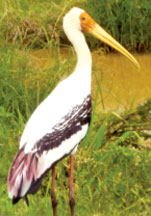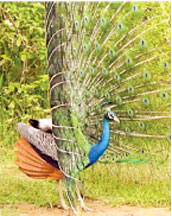Udawalawa National Park, a nature lovers’ paradise
By Premasara Epasinge
O, Give me a home;
Where the buffaloes roam;
Where the deer and antelope play;
Where seldom is heard;
A discouraging word;
And the skies are not cloudy all day
The above lines that I learnt from a former Director of Primary
Education, Dr. (Miss) Kamala Peiris, about the “Freedom that animals
should enjoy in their natural habitat”, flashed across my mind when I
entered the Udawalawa National Park.
I was away from the hustle and bustle of politics and cricket,
watching elephants at Udawalawa National Park.
Elephants are close to our heart, religion and Buddhist culture. This
is one of the reasons, elephants are very special to us.
 The greatest teacher, Mahapurusha Gautama Buddha was conceived in the
womb of Queen Mahamaya. She dreamt a baby elephant with a white lotus,
entering her womb. During the Buddhist era, there were two well-known
elephants - Parileyya and Nalagiri. Then, there are many Jataka tales
depicting the importance of elephants. Dummeda Jatakaya is a good
example. The greatest teacher, Mahapurusha Gautama Buddha was conceived in the
womb of Queen Mahamaya. She dreamt a baby elephant with a white lotus,
entering her womb. During the Buddhist era, there were two well-known
elephants - Parileyya and Nalagiri. Then, there are many Jataka tales
depicting the importance of elephants. Dummeda Jatakaya is a good
example.
There is a belief to be born as an elephant which is his last birth
in the animal kingdom. His next birth will be as a human being. The
elephant is a majestic and a proud animal. There is a special beauty in
him.
Colourful
An elephant is a fortunate animal. He is the only animal to carry the
Sacred Tooth Relic of the Gautama Buddha. In the perahera culture,
colourful elephants play a predominant role. He is the carrier of the
living Buddha.
On our arrival at the office of the park, the tourism officer,
welcomed all of us. He assigned a guide, Kapila Pushpa Kumara. We
purchased our tickets at a point, entered the salubrious environment -
Udawalawa National Park.
Our tour party proceeded along Veheragolla, Thimbiriyamankada,
Seenugala, Pokunettawa to Udawalawa National Park. The park has an
acreage of 30,821 hectares. It was declared a National Park on June 30,
1972 under the Fauna and Flora Protection Ordinance.
We witnessed a dance performance by a peacock. A herd of deer and
several other animals were at a distance. Many bird species filled the
greenery shrubs. They were marvellous sights.
The Udawalawa Park lies in the Ratnapura district in Sabaragamuwa
Province and Moneragala district in Uva Province. It forms the largest
conservation areas within these districts and largely comprise the lower
and immediate catchments of Udawalawa, and some parts of Mau Ara basin
in the East. The area to the West bank of Walawe River is within
Ratnapura District and on the East Bank, within the Moneragala district.
The picturesque Walawe Reservoir is situated in the park. The surface
area of it at full level covers about 3,405 hectares. There are some
ruins near Veheramankada and Veheragolla. Udawalawa Tank, Reservoir adds
more colour to the National Park. We saw many rare species of animals
and birds. The highlight and centre of attraction were the elephants.
Close to Veheragolla we stopped for a herd of elephants to cross the
path. Their rhythmic and majestic proud movements reminded so much of
the - Gajaga Vannama - a dance sequence of an elephant.
At one point we witnessed how the father and mother elephants were
trying to hide their greatest treasure sweet little baby elephant from
us covering him between the two of them. What a sentimental sight it
was. They are innocent and attractive. The more you see them, the more
you love them. The innocent elephants are our greatest asset in the
animal kingdom.
Access
The easiest and quickest access to Udawalawa National Park from
Colombo is through Ratnapura-Pelmadulla on Embilipitiya Road. At
Thimbolketiya, turn left at Udawalawa Junction and proceeds to
Tanamalwila.
Udawalawa National Park is very popular among visitors and foreign
tourists. I presume there are nearly 500 elephants freely roaming the
beautiful park. Then, there are sambur, spotted deer, barking deer, wild
boar, water-buffalo, toque-macaque, common langur, sloth bear, toddy
cat, jackal leopard and mongoose.
  There were birds aplenty, including a large number of warblers, water
birds, Sri Lanka jungle fowl, horn-bill and brown capped babbler. At
Udawalawa National Park the soil and climate conditions are responsible
for classified vegetation types. The predominant ecosystem of the park
area is the forest with scattered grasslands and thorny-shrubs. There
are satin (Chloraxylan swietenia), Halmilla (Berrya cordifolia), Ebony
(Diospyros ebenum), Ehala (Cassia-fistula), Kolon (Adinacordifolia),
Milla (Vietex pinnata), Kon (Scheleichera oleosa), Kunumella
(Diospyrosovalifolia), Kumbuk illuk (Imperata cylindrica), Kohon
(Pennissetum olystathyon Terminalia arjuna, Mandorang (Hopea cordifolia)
trees are in plenty. There were birds aplenty, including a large number of warblers, water
birds, Sri Lanka jungle fowl, horn-bill and brown capped babbler. At
Udawalawa National Park the soil and climate conditions are responsible
for classified vegetation types. The predominant ecosystem of the park
area is the forest with scattered grasslands and thorny-shrubs. There
are satin (Chloraxylan swietenia), Halmilla (Berrya cordifolia), Ebony
(Diospyros ebenum), Ehala (Cassia-fistula), Kolon (Adinacordifolia),
Milla (Vietex pinnata), Kon (Scheleichera oleosa), Kunumella
(Diospyrosovalifolia), Kumbuk illuk (Imperata cylindrica), Kohon
(Pennissetum olystathyon Terminalia arjuna, Mandorang (Hopea cordifolia)
trees are in plenty.
There are about 30 guides to take you around the park. There are a
few camp sites at Udawalawa National Park such as Alimankada,
Pilimaddhara, Fransaddha and Renegala.
If you are an “Elephant Lover”, and a lover of the environment and
peace, Udawalawa National Park is ideal for a visit.Visitors should
refrain from taking or destroying any plant or animal, not disturb the
animals, never throw garbage, cigarette butts, never play musical
instruments, audio cassettes or radios and disturb the animals. A
journey to the Udawalawa Park will be an unforgettable and a memorable
one. |



